On the last day at OFFF in Barcelona, Matt Pyke gave a little walk-through of his work at the Designers Republic and especially all the things he has been setting up (from a lovely garden in Sheffield) with his multidisciplinary studio Universal Everything since he has left there.
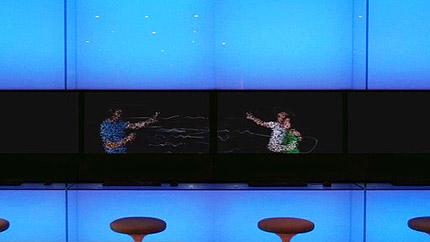
Especially nice were the 20.000 generated characters for the Lovebytes festival which instantly became the subject of collecting and their installations for the Nokia store in NYC. On its screens you see people which are basically flocks of pixels which interchange parts of each other when calling – creating a simple yet poetic visualization of the company’s “connecting people”-mantra. They also have a blog called Everyone Forever on which Universal Everything collect stuff that inspires them.
Later that day, it was John Maeda’s turn which put me in a similar position to Régine when Bruce Sterling was talking at IFID since it was more of an eclectic lecture to inspire his numerous audience which is naturally difficult to write up. We’ll try anyway:
Actually, John Maeda never wanted to talk about his work in front of audiences like this again ever since an illustrator told him that his computer-based work “is so empty”. It’s much better to talk about ideas anyway. One of his latest ideas was Simplicity but he’s already getting tired of that by now. When he got really tired, he went on a vacation at Cape Cod, Massachusetts. He needed to get khaki shorts, so he went to a GAP store and there was even more simplicity (“Keep it simple”), switch on the TV and you see Paris Hilton living “The Simple Life” and the list goes on. But maybe we just love complexity too much to make everything simple. Take the MIT media lab, a place which, thanks to I.M. Pei‘s architecture, looks very simple from the outside. Yet, it’s a very complex place. While at Google, you get free smoothies (and accumulate the dreaded Google 15), in academia there’s no such thing. Instead they give people titles, lots of them, making their lives ever more complex with growing responsibilities. As he also describes in his book Maeda@Media, John grew up in a family-run tofu factory in Seattle. Tofu also is simple food, but the edamame beans it is made of need to go through a complex process to become the final product. This was a very spartan education and made him thoroughly enjoy studying at school. When it was time to choose a college, he went for MIT’s media lab, which, from above, coincidentally also resembles a chunk of tofu. He met Muriel Cooper who told him to go to art school which is what he did and where he met more mentors like Paul Rand and Ikko Tanaka who were all very advanced in their careers and focussed more on humanizing their students than anything else.
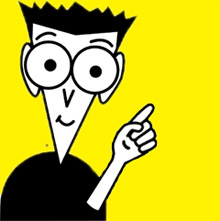
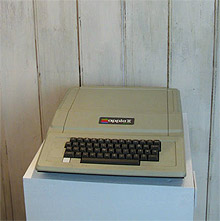
John Maeda (sort of) and his Apple II
Early in John’s own professional career, Japanese cosmetics-company Shiseido had him working “like Batman, teaching by day, arting by night”. Yet, many would consider his work to be “eye candy”, a term which he would like to see replaced with “eye meat” since it tries to get to the core of the question about how to create with computers. Back in those days, Maeda got an Apple 2-computer for $1500 and it did nothing. In 1995 in Kyoto, he built the “Human Powered Computer” which replaced all the mysterious inner workings of the machine with people. Quite funny and it lead him to better understand the spirituality of the machine. Many said that “the computer is nothing more that a pencil”, a statement which made many designers and artists feel comfortable with great changes already on the horizon. It is indeed a great tool, but we’re still trying to find out what kind of tool it really is. Every today’s software works a bit like a tree with alternatives branching out everywhere. Problem is, when you try to make art you always get stuck on that tree. And: paradoxically, true art will always be off that tree entirely.
After realizing that, John went to play with his old computers as “post digital” robotic devices, including an optical mouse which is taped to a screen and moves itself, a typing machine and a crash-test setup involving a CD-tray and another poor mouse. He went on into materials, sanding off blocks of acrylic and rolling out blue tape until first his wife told him to stop that and then 9/11 happened which made him want other things. Maeda went back to the screen, scanning cheese puffs and pretzels and generating “Cheesepaint-men” and butterflies. There were more objects however, “Egg2D2” being one of them who unfortunately was destroyed when a visitor bumped into him during an exhibition. Recently he has been devoting more and more of his time to MIT where he’s heading the Physical Language Workshop-group.
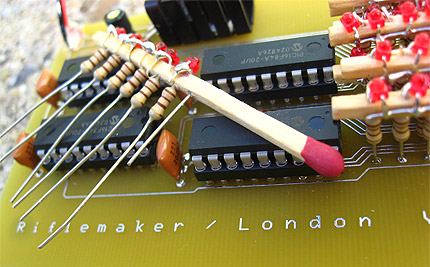 Digital fire that taunts the potential fire
Digital fire that taunts the potential fire
Everywhere he looked though, John wasn’t sure what to think of the world anymore. A discarded screen made him realize that computers must be sad since we’re abusing them all the time. A search engine crashed when he was searching for “love”, is technology even talking to us? Is simplicity the sauce behind which complexity is luring? Eerily, even the letters MIT. appeared in simplicity when he wrote it in the sand during the mentioned vacation. John decided to devote himself to simplicity and write a book about it, as if there weren’t enough books for simple people that feature a guy on their cover to who (according to John’s daughter) he bears great resemblance.
His book The Laws of Simplicity is a collection of ten laws of varying difficulty, a bit like challenging and more easy kinds of sushi. To understand the many things related to simplicity, you can use the cookie-versus-laundry concept: If you offer to a kid a big or small cookie, the kid will chose the big one. If you want someone to wash a big or small pile of dirty laundry, they will pick the small pile. So we want more when we get to enjoy but we want less when it is something painful. Ideally, simplicity means more joy and less pain.
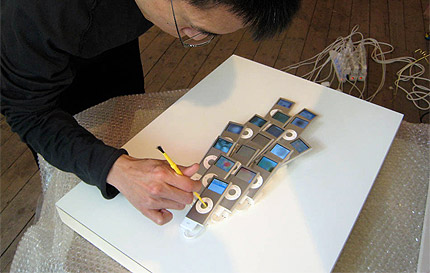
Setting up the iPod-fish (photo stolen from Sutje)
John Maeda recently opened an exhibition at London’s Riflemaker gallery which features some new and older pieces by him (video walk-through). There is the digital fire (LEDs) that taunts the potential fire (matches) which could destroy the digital part if only ignited, A fish built from 16 iPods which contain some sixty-thousand visual memories that “swim away” from him, two iPods that play in and out of sync (until one of them “dies”) and John’s Second Life-avatar who you can take for a spin in the metaverse.
Related: Interview with Amber Frid-Jimenez and Brent Fitzgerald, Interview with Burak Arikan, Sam Hecht’s talk at the Simplicity symposium
